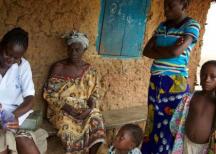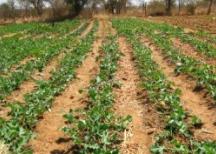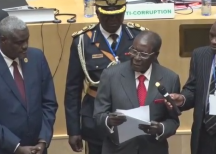
Much of the energy expended by official ‘world-savers’ – governments, policy wonks, multilateral institutions and the like – is devoted to devising news ways to cash in on the next ‘development’ era.
In his great novel, A Tale of Two Cities, Charles Dickens identifies, strips down, amplifies, and speaks to the tensions innate in the human existence. For in our world, brutality and exploitation are equally matched by goodness, courage and the human capacity to change.
It is for this reason that Dickens, whose novels engaged the structural reality of oppression, begins his Tale with the words, ‘Iit was the best of times, the worst of times, the spring of hope, the winter of despair…the age of wisdom, the age of foolishness…we had everything before us, we had nothing before us.’
More than anything else, the novel stands as documentation of brute power systems structured by vulgar indifference to the living, present and future.
And any unconscious person born into these systems become part of their reproduction.
Dickens’ words stand true for all time, and they repeatedly popped into my head during the Durban-hosted 17th Conference of the Parties (COP17) to the United Nations Framework Convention on Climate Change.
Much of the energy expended by official ‘world-savers’ – governments, policy wonks, multilateral institutions and the like, was devoted to devising news ways to cash in on the next ‘development’ era.
Better than the usual crude formula of hunger and poverty captured in the image of slum-babies with swollen belly, was the same lethal cocktail hooked on a new cashable cause: mega-climate crashes.
Descending like rabid dogs were multinationals, directly or indirectly, sponsoring various events; and ‘development specialists’ from the Big International NGOs (BINGOs), many creating future consultancy contracts for themselves. Too many of the latter were funded by the former in ‘partnerships’ that profit the partners and peril the planet and its peoples. (As an article published on The Africa Report, ‘big foundations comprise just 2 per cent ….lobbying for narrow interests such as carbon trading, receive more than half of all funding.’ Citing a report authored by Sarah Hansen, titled Cultivating the Grassroots, the article continued, ‘The report described how the $10 billion in 'green funding' during the past decade had failed to generate any 'significant policy changes at the federal level in the United States since the 1980s.' Just 11 per cent of funds was connected to social justice issues, from which most ecological degradation usually stems. But large funds largely elided the impacted communities, primarily those of color.)
Peppering the landscape were also idealistic - and opportunistic - students (as well as some fashionable slummers) parachuting in without visa delays and costs thanks to their developed-world passports. Most people from both groups assumed that such credentials would immediately, and magically, add some value to ‘Africa’.
The streets stank of hope, hedging, opportunism, hypocrisy, and deal-making. The civil society march of several thousand, culminating in a shameful obeisance to UNFCCC leaders Christina Figueres, was an organized and self-defeated sham without any proper message except ‘do more!’, which in turn legitimized what former Bolivian UN Ambassador Pablo Solon** termed ‘genocide’ planning by the UNFCCC. Before joining the UNFCCC, Figueres was a carbon trader, and to signify the COP17’s failure on even their own for-profit terms, the carbon markets promptly crashed.
Meantime, local politics also added a toxic element. Durban municipal manager Mike Sutcliffe’s paid ‘supporters’ garbed in green with UNFCCC and Durban logos, happily beat some activists after yanking their placards away. They were paid, it is estimated, some $25 per day, plus the free tracksuit.
What serious attempts, then, at opposition? To their great credit, many local movements and genuine foreign counterparts tried their utmost to move mountains. But where were the leaders of the global social justice movements, always so vocal, invading our email boxes daily for marathon click-athons – to save the wolves, babies, whales?
At one point, I and another member of the Africa Report COP17 team passed a bunch of security officers who were briefed not to be ‘soft’ to those without adequate credentials.
Whose credentials shone from the start?
For one, those of Kumi Naidoo, the Durban-born head of Greenpeace. Ever eager to please, it seemed, he managed to scupper the ‘Occupy Cop17’ peaceful civil disobedience at the ICC death-trap, by gently reminding activists that their presence would upset the officials. His reasoning? “Nobody can accuse us of disrupting the negotiations, all we want to show is our support of the most vulnerable in the negotiations”.
Would Naidoo’s version of moderation have broken apartheid? Brought basic rights for people of color in the US? Is it better to leave the dirty system in place than upset the overseers?
Greenpeace and other organizations such as 350.org dominated the process, dumbed it down, and diminished the potential for transformation. After all, who needs Shell, when the local-born leader of one of the largest global green-muscle resistance movements, cleans the room out for them?
God forbid peaceful occupation upset the people with big banks accounts, polluting the world, unchecked.
Any journalist camping out at the Occupy COP triangle and the like, would have been sorely disappointed at the lack of a civil disobedience story. As Dickens wrote, “along the streets, the death-carts rumble, hollow and harsh.”
In this, Naidoo disappointed many people in the extreme. I was told by young activists that Naidoo was a hero. I imagined, thus, that while managing the politics, he would not compromise the integrity of the ecological justice. That he would lead from the front, fearlessly. I imagined he would inspire and command his ‘troops’ to peacefully occupy the convention centre, lock in the ministers, and force them toward the only logical conclusion: curbing emissions drastically.
But power was once again carefully deposited by the BINGOs to the same political baby-steppers --- sans diapers. Once again, the shoes of hopeful people were forced to trudge through crap.
Take the World Bank’s newest initiative: climate smart agriculture.
“COP 17 in Durban offers a unique opportunity for Africa to shape the global climate agenda and establish an agriculture work program that is informed by science,” said the World Bank on their Climate Change website.
The Center for Civil Society (CCS) commissioned by the EJOLT (Environmental Justice Organizations, Liabilities and Trade), recently produced a book on CDM’s in Africa*, peeling back the greenwashing of projects, including climate smart agriculture.
What’s it about?
The push behind the newest agricultural ‘revolution’ is driven by many factors ranging from multinationals such as Monsanto, eager to embed the money-making intellectual property of genetically modified seeds, to that of mega-dam proponents. But we would not be wrong to identify its most visible proponents: the World Bank and South Africa.
The momentum of both, in fact, is closely intertwined: in September 2011, three months after she collided with ‘climate smart’ ways at the UN Food and Agricultural Organization’s (FAO) event in Rome, Agriculture Minister Tina Joemat-Pettersson began advocating the ‘climate smart’ concept, she organized the Bank-funded meet and greet with Africa’s agricultural ministers. The UN’s FAO would have been a good ambassador: in their document on the concept, the FAO states, ‘Climate-smart agriculture is rooted in sustainable agriculture and rural development objectives which, if reached, would contribute to achieving the Millennium Development Goals (MDGs) of reducing hunger and improved environmental management.’
According to this FAO report, not only is the agricultural sector the most vulnerable – in Africa, over 90 percent of small farmers will experience drastic crop reduction in the next few decades – but it is also one of the leading producers of GHG, estimated at 14 percent , and ‘a key driver of deforestation and land degradation, which account for an additional 17 percent of emissions.’
The concept extends, in many instances, to the entire economy, including ‘environmental issues, for example energy and water, as well as social issues, such as gender, and economic issues. Achieving the four dimensions of food security (availability and access to of food, utilization of food for adequate nutrition, and stability of food supply) needs to be the overall goal of food production and distribution systems in developing countries.’
The Trojan horse is green-wrapping well-established and known practices such as conservation, within the context of the key solution: ‘Financial mechanisms …that can blend and coordinate funding from different sources, including public, private, agricultural development and climate financing.’ As South Africa’s Department of Agriculture revealed that ‘considerable finance will be needed to rapidly implement climate-smart agriculture.’
The country, the gateway facilitating exposure, particularly through the recent COP17, irrevocably backs the concept, using justice-speak (‘agriculture is the economic foundation…employing about 60 percent of the workforce and contributing an average of 30 percent of gross domestic produce…’) to motivate for the location of solutions in neoliberal market-mechanisms.
How will this be realized? ‘The whole proposal of Climate-Smart Agriculture was developed around the possibility of developed countries offsetting their carbon via international carbon market - REDD, REDD+ and soil carbon market. (The UN-REDD Programme is the United Nations Collaborative initiative on Reducing Emissions from Deforestation and forest Degradation (REDD) in developing countries.) Climate-Smart Agriculture comes packaged with carbon offsets,’ writes ActionAid.
Unpacking the reasons why initiatives such as ‘climate-smarts’ soil market won’t work , ‘there is no soil carbon market currently, if there were a market, it would not provide revenues to farmers, the system will be biased against smallholders, to sustain finance from an offset market, developed countries must keep emitting, soil carbon markets are a distraction from addressing real adaptation needs and mobilizing real funding to support adaptation’, and that ‘soil carbon markets are a diversion from real obligations of rich countries: to reduce emissions and to provide substantial, stable, predictable, new and additional public finance.’
But before any of these issues can be considered, – and aside from the fact that many African farmers, cultivating just one or two hectares of land for subsistence would earn perhaps $3 per annum – most African farmers don’t hold legal rights to the land on which the banking scheme is intended to take place.
Smuggled through in the process - as solutions - are high-cost environmentally destructive ‘inputs’ such as fertilizer and pesticide, genetically modified seeds, mega-dams and ill-designed irrigation projects, geared to sustain not Africa’s food needs, but rather, commercializing crops through the usual power structures.
The process is already under way: Inter-Press Service (IPS) detailed of the venture: ‘The very first project to sell soil carbon credits in Africa is underway in Kenya. Funded by the World Bank, some 15,000 farmers and 800 farmer groups are changing their practices to sequester carbon for a 20-year period. The costs to set up the Kenya Agricultural Carbon Project along with the costs involved in measuring the carbon and marketing the credits are estimated at more than one million dollars, said Anne Maina of the African Biodiversity Network in Kenya.’
“During the question and answer session at the launch of the Bank’s third ‘tranche’ of its BioCarbon Fund (which finances soil and forest-based initiatives), a young woman spoke up who had worked for a Bank-funded soil carbon project in Kenya,” said Keith Brunner, Global Economic Accountability Research/ “She referenced a report from her organization which revealed how the focus on carbon finance and mitigation has posed real dangers for food security and rural community livelihoods, with most of the finance ending up in the pockets of private companies and project developers.
“A representative from CARE International working in Africa piped up and said that they are facing soil carbon projects where the financial break-even point for the farmers won’t be reached for 10 years.
‘…The World Bank sees an immense new investment frontier, through the creation of agriculture-based carbon offsets which can be bought and sold on global markets.”
“Crush humanity out of shape once more, under similar hammers, and it will twist itself into the same tortured forms,” write Dickens. “Sow the same seed of …oppression over again, and it will surely yield the same fruit according to its kind.”
But the good news, as Brunner points out, is that civil society can make a difference.
“Thanks partly to heavy organizing and a letter signed by over 100 civil society organizations from Africa and around the world calling for the UN to reject efforts to consider agricultural soils within carbon markets, it didn’t happen.
“At least, not yet,” he cautioned.
If civil society – including doctors, lawyers, journalists, receptionists, farmers and the like, are to prevent such shenanigans from happening, power must be taken back, narratives put into context, realities broadened. Civil society, like the monk Martin Luther, must nail these theses – in all their diversity and differences and similarities, to the global doors of power. This must be done through global umbrellas represented by local movements that represent real – as opposed to internet or consumer – constituencies.
First in line should be the microphones of NGOs and development specialists who claim to represent the public interest. Such green ‘peace’, as espoused by these specialists, is structuring the foundations of myriad global wars over ecologies claimed by the wrong people for the wrong purposes.
This is not to say that Greenpeace and other similar organizations are wrong in the substance of their arguments, but simply that lack of strategic implementation at the right time, targeting the right people, is as necessary as research advocacy, particularly for movements that claim the stage in such circumstances. Failure to do so reinforces and even legitimizes the power of those who commit the wrongs Greenpeace claims to stand against.
This, after all, is one of the key lessons of Dickens book: the danger when revolutionaries begin to perpetuate the same horrors, through the same tactics, as the oppressors.
* BROUGHT TO YOU BY PAMBAZUKA NEWS
* Please do not take Pambazuka for granted! Become a Friend of Pambazuka and make a donation NOW to help keep Pambazuka FREE and INDEPENDENT!
* Khadija Sharife is a journalist and visiting scholar at the Center for Civil Society (CCS) based in South Africa.
* Please send comments to editor[at]pambazuka[dot]org or comment online at Pambazuka News.
NOTES
*The author assisted in the process.
** Solon – interviewed by the author COP17 - did not resign from the Bolivian government during the genocidal planning of the TIPNIS highway in Bolivia, though he issued a strongly worded letter against the mega-development plan.
- Log in to post comments
- 1192 reads



































